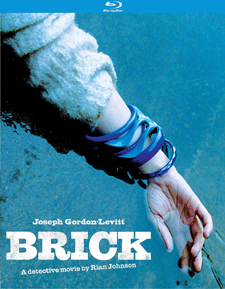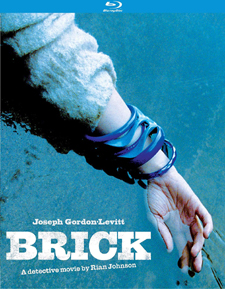Brick (Blu-ray Review)

Director
Rian JohnsonRelease Date(s)
2005 (January 7, 2020)Studio(s)
Bergman Lustig Productions/Focus Features (Kino Lorber Studio Classics)- Film/Program Grade: B-
- Video Grade: B
- Audio Grade: B
- Extras Grade: A
Review
Brick, a neo-noir thriller from writer/director Rian Johnson (Star Wars: The Last Jedi), takes place in a present-day California high school but is written in the style of Dashiell Hammett and Raymond Chandler. Teenagers use colloquialisms of the late 1940s and 1950s like “take a powder,” “I’ve just shaken the tree; let’s see what falls,” “keep your specs peeled,” “shamus,” and “kablooey.” The highly stylized narrative opens with the image of a dead girl at the mouth of a tunnel followed by the title “Two Days Earlier” and an extended flashback, a device reminiscent of William Holden’s body floating in a swimming pool in Sunset Boulevard and narrating his own tale.
Brendan (Joseph Gordon-Levitt, The Lookout, Looper) is a loner who still has feelings for his ex-girlfriend Emily (Emilie de Ravin), who dumped him for the hip, druggie crowd that Brendan hates. Emily hasn’t been seen for days, so when Brendan gets a phone call from her that sounds frightened and is quickly cut off, he starts to ask questions. Assisted by his buddy The Brain (Matt O’Leary), Brendan learns that Emily became involved in a plot to steal a brick of pure heroin from a local dealer called the Pin (Lukas Haas, Witness).
Writer/director Rian Johnson turns 1940s pulp characters into youngsters and the actors play their roles dead seriously. There’s violence, mostly in the form of brutal fist fights. The hard-boiled style becomes apparent almost immediately, as actors speak in idioms their grandparents would have used. This style is not an attempt to be campy or cute or to elicit laughs. The mood is consistently somber as the murder mystery plays out, with colorful characters, red herrings, and Brendan’s determined detective venturing into dangerous territory to find out the truth about Emily.
Joseph Gordon-Levitt never cracks a smile, suggesting Bogart in The Maltese Falcon. His Brendan can handle himself physically, belying his thin frame, soft features, long hair, and glasses. In one scene, he stands up to a muscle-bound football player, taunting him about his limited vocabulary and using surprise and speed to compensate for his smaller size. He ends up badly beaten but still has held his own. Making Brendan both cool and destined for doom, Gordon-Levitt plays him on a single note, which becomes tiresome. In moments when his character should express anger or frustration, he is stone-faced. Even Bogart showed emotion from time to time.
Brick is certainly an original, with its hipster dialogue, incongruous setting, sinister goings-on in high school, near absence of adults, and teenage femme fatales. This is a world ordered by its own internal logic. As with classic detective fiction, there are many characters, complex relationships, questionable motives, suspicious behaviors, and important clues. First-time director Johnson presents an aggressively stylized, twist-filled melodrama that turns the mundane setting of high school into a simmering den of danger and violence.
The Region A Blu-ray release from Kino Lorber Studio Classics contains a brand new 4K restoration supervised by Rian Johnson. Featuring 1080p resolution, it is presented in the widescreen aspect ratio of 1.85:1. Johnson purposely avoids the look of classic film noir. Filmed in color, mostly in daylight, it occasionally uses camera flares so that actors are backlit and seen in silhouette. In a scene in a basement, a ray of sunlight shines through a high window. Brendan uses a mirror to reflect the sunlight onto different areas, one at a time. When Brendan speaks into a phone, he is lit only by the light on top of the booth, providing atmosphere. In a few shots, people approach the camera from a distance, creating suspense as we wonder who they are and whether there will be a confrontation. Johnson uses long shots not only to establish locations but also to show a wide, unobstructed panorama, which is the exact opposite of noir’s typically claustrophobic settings.
There are two English soundtrack options, 5.1 and 2.0 DTS-High Definition Master Audio. English subtitles are available for the hearing impaired. This is a dialogue-heavy film in which the spoken word is a significant aspect of the film’s stylization. Teenagers talk like gumshoes, femme fatales, and slick crime bosses. Dialogue is crisp and distinct. The fight scenes are enhanced with effects to make them both sound and appear real. When Brendan visits a character in a school dressing room, we hear a distinct echo and the sounds of a mirror smashing with shards hitting the floor and scattering about. Footsteps create suspense in scenes in which Brendan is chased. As the volume overall is lower than typical Blu-rays, viewers may want to adjust.
Bonus materials include an audio commentary with writer/director Rian Johnson and key cast and crew members; 8 deleted and extended scenes; The Inside Track: Casting the Roles of Laura and Dode; and a set of theatrical trailers.
Audio Commentary – Writer/director Rian Johnson shares this commentary with actors Nora Zehetner and Noah Segan, producer Ram Bergman, production designer Jodie Tillen, and costume designer Michele Posch. Johnson was fascinated with Dashiell Hammett’s novels and initially wanted to do a straight-up detective film but decided to give it a different set of visual cues. He graduated from film school in 1996 and wrote the script for Brick in 1997, but had no connections in the industry and was not great at putting himself out there. The slow process of getting the script to industry people and ultimately to the finished film took 6 years. He took day jobs to “keep himself fed” as he tried to raise the money through traditional sources, but because the script was weird and he was a first-time director, there was little interest. Johnson felt the film was “execution reliant;” in the wrong hands it could wind up a train wreck. Johnson finally found a producer he could trust who told him the realities of getting money together and shooting a film. A casting director was also hired with connections to many agents. Paring the budget to just under $500,000, Johnson raised the funds from family and friends. The film was shot at Johnson’s old high school in San Clemente, California, under “guerrilla filmmaking circumstances.” Zehetner discusses the script’s language and her performance style. Tillen describes improvising location shoots at parking lots and storage facilities, and using a shopping cart for tracking shots. Despite the low budget, “every day we made our day and covered the material.” During the audition process, Johnson saw many young, talented actors who were drawn to the material because it was unusual. He discusses the tradition in movies of actors in their twenties playing teenagers, which goes back to Rebel Without a Cause. There was great interest in distributing the film after it premiered at the Sundance Film Festival. Johnson is quick to note that the film is not a realistic take on high school but a film that exists in its own universe. “Brick is to high school as Gotham City is to New York City.”
Deleted and Extended Scenes – Rian Johnson introduces each scene, noting that the first cut was put together quickly. Because viewers were often confused, he added material to clarify and cut other material that might confuse. After the film was shown at Sundance, Johnson felt it was better to make the film more ambiguous as to whether Brendan and Laura had sex. He discusses pick-up shots and reshoots. In the field scene, when reshoots were needed, Astroturf had been installed, changing the entire look of the field and necessitating low-angle shots.
The Inside Track: Casting the Roles of Laura and Dode – The audition tapes for Nora Zehetner and Noah Segan are shown.
Trailers – Theatrical trailers for the following movies are included: Brick, The Ice Harvest, The Interpreter, Broken Flowers, and Thirst.
– Dennis Seuling

